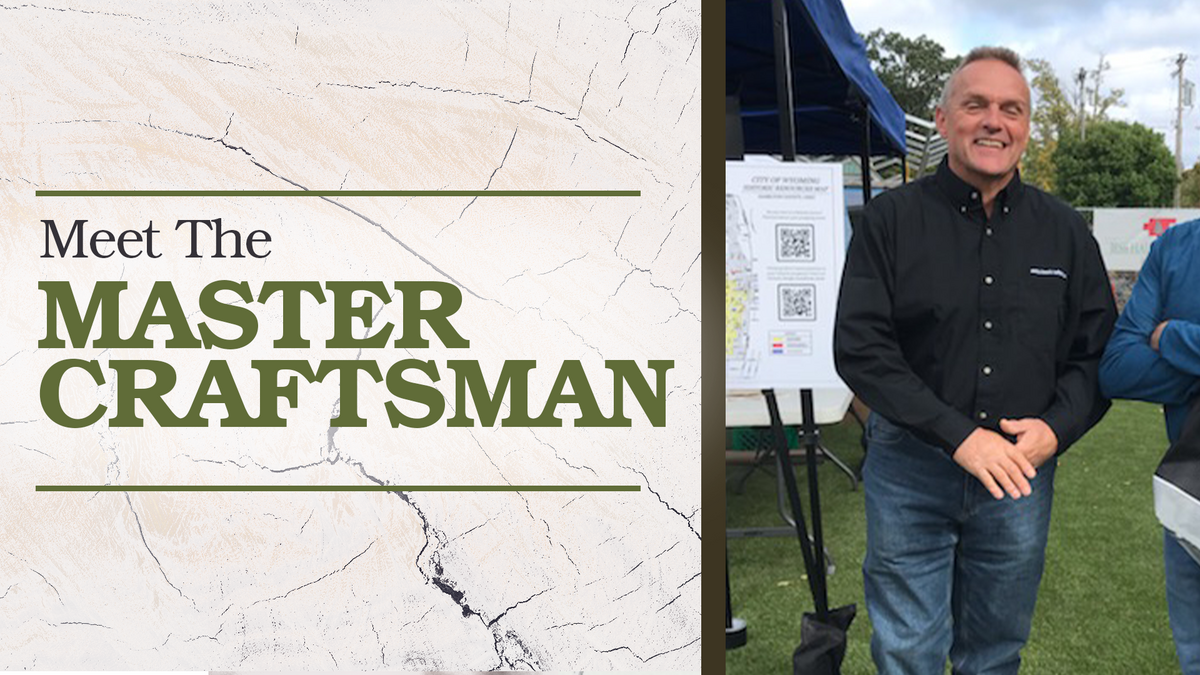Meet the Master Craftsman

My name is Brent W. Sears and I am the master craftsman at Old School Craftsman. Together with my son and apprentice Brendon, and my wife Trish, we make up the Old School Craftsman team.
Over the years, many of my clients, friends, and partners have asked me about my career as a craftsman. I love to reminisce about my favorite projects, but there is only so much time in a day! I wanted to set aside some time to write down some of my experiences and my journey from my first projects to becoming the master craftsman I am today.
Please come along with me as I recount my journey from a kid who followed his grandpa from job to job to the master craftsman who is trusted with building custom additions to treasured homes.
The Blueprints of My Career
My interest in building and craftsmanship began with my grandpa. Grandpa was a big inspiration for me growing up because he was very handy and made a living doing odd projects and fixing up structures around town. He was a step above a handyman, and as a boy, I believed he could fix anything.
Grandpa had an amazing work ethic and he taught me how to stick with a job from start to finish. His mentality was that it was important to do things the right way, even when no one is looking – integrity at its finest.
The first project I can remember was building a doghouse with my grandpa at seven years old. We owned a small border collie, and we needed a small shelter for the dog in our yard.
Grandpa helped me through the process of building the doghouse, and we even designed a custom mechanism to help us clear the straw out from the bottom. I remember this project had a profound effect on me because it allowed me to exercise a bit of creativity. We weren’t just following a blueprint or series of instructions; we were exercising our minds to build a project that was right for us.
By this time, I already knew that I wanted to work as a craftsman. As I got older my career would take root, but even at the time of this first project the instincts of a master craftsman already lived deep inside of me.
Laying the Groundwork
My first professional job came when I was in high school. Other than my grandpa, my first mentor was a contractor by the name of Bob Hanley.
He was a hard worker and tough as nails. Most of the time, Bob had me help him cut rafters and build steps. Whatever the job was, Bob did it. His favorite phrase (and one I heard often) was “You can rest when it's raining.”
The interesting thing about Bob was that when he built roofs, he built them using sticks, instead of tresses. For those who don’t know, stick roofs involve a building process that uses rafters and requires a great deal of precise measuring. This contrasts with trusses, which are usually premade triangles that make the roof-building process much quicker. Of course, when you build a roof with trusses it is less stable than those built with stick. This was one of the first lessons I learned about the importance of old-school craftsmanship.
By the time I was wrapping up high school, Bob retired. With Bob out of the business, I set out on my own. The day after I graduated high school, a couple of my friends and I had a job lined up. That’s how I spent the next few years, doing general contracting work and collecting experience.
I remember thinking that I was as strong as a bull and just as eager. Every project was exciting to me, and I was doing exactly what I was made to do. In the next stage of my career, I would start doing commercial work. Of course, that wouldn’t last forever, but it was an important step in my journey.

Commercial Work Isn’t All It’s Cracked Up to Be
The year was 1993 and I got a call from a guy named Tom Wilcox out of Michigan. Of course, today I know Tom well and he is one of my most trusted partners, but back then our relationship was just beginning. I knew Tom as a high-character individual and architect, so when, on that call, he asked me if I was interested in doing some work for a retirement home, I was all ears.
How do architects and builders work together on home remodels? Learn more in this blog!
The retirement home project was my first commercial job. From that point until the late 2000s, I was a business owner. I had about 26 employees working under me, an office building, and dozens of assets. We did all sorts of commercial work, including churches, libraries, and anything else in the Loveland area. We were doing very well in those years, but the stress was overbearing.
I was wearing too many hats and I never had time to do what I wanted to do. The economic downturn in the late 2000s turned out to be a blessing in disguise. We ended up shutting down commercial operations and Tom Wilcox helped me get back into independent work. It was at that point that I truly became a master craftsman.
Becoming a Master Craftsman
I don’t remember exactly when it happened, but sometime around five years ago, I began to hear clients and partners refer to me as a master craftsman. This came from other builders, plumbers, and electricians.
Just to clarify: I don’t have any certification that says I am a master craftsman. No such certification exists the same way it does for an electrician or plumber. Instead, the title “Master Craftsman” is something my partners began calling me five or more years ago. I thought it had a nice ring to it (and it fit well on a business card), so I started using it.
However, I am a master in the sense that I have perfected the skills necessary to handle custom home projects on any scale. There are so many skills to learn when it comes to home building and I am not a master at all of them, but I have mastered the skills that my clientele needs.
The Old School Craftsman Code of Honor
From time to time, people will ask me if I have a code of honor. Sometimes they will even assume I have a refined code of ethics that I follow. The truth is that I have nothing so formal. Instead, my philosophy is very simple.
The founding principle of my career is this: Be honest.
When you work in someone's home, they are placing a tremendous amount of trust in you. As a craftsman, it is so important to work with crystal-clear communication and unflinching honesty.
As a part of this philosophy, I create a weekly report for all my clients. This report includes everything I accomplished in the past week and an outline of what I will do in the next two weeks.
The subcontractors I hire are people that I have known and worked with for upwards of thirty years. I believe that subcontractors represent me and my business. That’s why I only work with people I trust completely. I don’t buy into “production framing” (where you work as fast as you can so you can get done ASAP and move on to the next project to increase your profit), and neither do my partners.
I trust my subcontractors to take their time and do things the right way, and in my three decades of experience, they have always delivered.
In addition, before I start any projects, I create a hyper-detailed proposal of every step of the process. I include even the most minute details and oftentimes these reports are over two hundred pages.
To conclude, I believe there is no such thing as halfway done for a construction project and it is vital to communicate every detail so that the client will know exactly what will happen on every step of the way.
When you build a home, there is a code that determines the minimum standard of quality. My team and I go well above and beyond that minimum. We build houses we would want to live in, and that starts with doing the little things the right way.
The Future is Bright
Now that I have spent some time reminiscing, let’s take a minute to look to the future.
As many friends and trusted partners know, the Old School Craftsman team recently completed our workshop. This workshop features many exciting tools and machines that will help Brendan, Trish, and me take our abilities to the next level.
Learn more about the Old School Craftsman workshop here!
Brendon is my apprentice and the motivation behind this project was to create a space for him to be able to launch his own vision of his career. One important feature of this process is the introduction of a CNC robot.
The CNC robot is a tool that allows for the advanced fabrication of pieces like spindles so custom pieces can be fabricated in-shop.
This will allow Brendon to have the work come to him. He will be able to make custom pieces in the workshop which can then be shipped anywhere in the country. This will let him focus on historical restoration pieces and let the Old School Craftsman business take a deeper dive into historical specialization.
Custom Historical Restorations with Old School Craftsman
Thanks for joining me on a retrospective look at my career. It was a lot of fun to take some time to reminisce and remember some of my favorite projects.
I am excited about the future and continuing to work with Brendan and Trish as a part of the Old School Craftsman team. Historical restorations are such exciting endeavors for our team, and we are proud to use our considerable experience and the principles of old-school craftsmanship to perform historical restoration projects with the care and attention to detail that they deserve.
If you have a historical home you want to restore, then reach out to the Old School Craftsman team today!
Follow us on Facebook, Instagram, and Pinterest for more discussion on historical homes and updates from our most recent projects.
Happy with the difference Old School Craftsman made on your home refurbishment? Leave us a five-star review here!
